ard-control Bedford TKs except tippers, id the striking characteristic is
Page 167
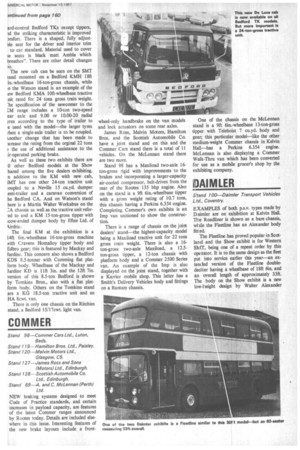
Page 168
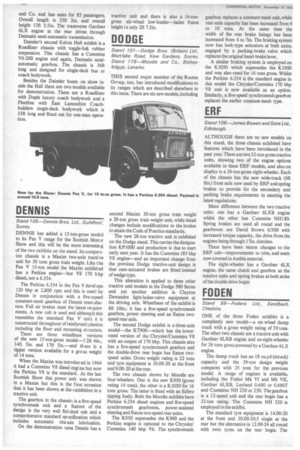
Page 169
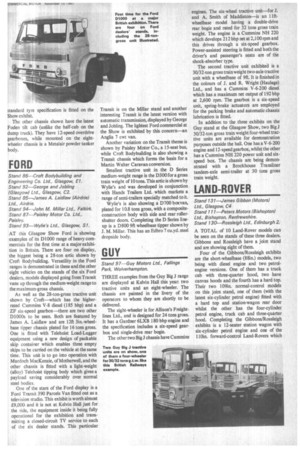
Page 170
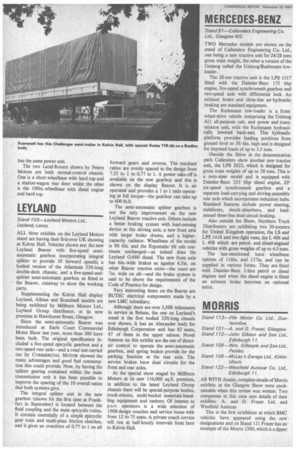
Page 171
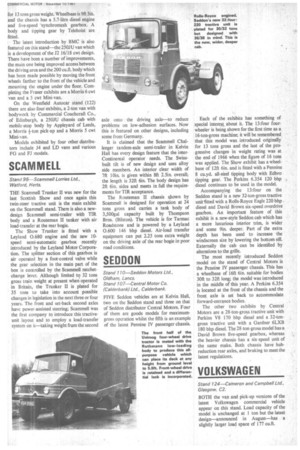
Page 172
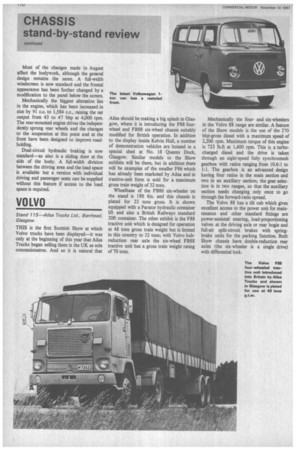
If you've noticed an error in this article please click here to report it so we can fix it.
improved Dmfort. There is a shaped, fully adjustble seat for the driver and interior trim to car standard. Material used to cover ie seats is black matt Ambla which breathes". There are other detail changes )o.
The new cab can be seen on the SMT Land mounted on a Bedford KMH 1811 in.-wheelbase 16-ton-gross chassis, while in the Watson stand is an example of the iew Bedford KMA 10ft-wheelbase tractive init rated for 24 tons gross train weight. The specification of the newcomer to the range includes a 10-ton two-speed ear axle and 9.00 or 10.00-20 radial yres according to the type of trailer to e used with the model—the larger tyres then a single-axle trailer is to be coupled.
wother change that has been made to crease the rating from the orginal 22 tons
3 the use of additional assistance to the
ir-operated parking brake.
As well as these two exhibits there are 0 other Bedford models at the Show hared among the five dealers exhibiting. n addition to the KM with new cab, MT has one other 24-ton tractive unit :oupled to a Neville 15 cu.yd, dumper :emi-trailer and a caravan conversion of he Bedford CA. And on Watson's stand here is a Martin Walter Workabus on the 2A chassis as well as the tractive unit refered to and a KM 15-ton-gross tipper with ;cow-ended dumper body by Eftee Ltd. of Airdrie.
The final KM at the exhibition is a 14ft 6in.-wheelbase I6-ton-gross machine with Cravens Homalloy tipper body and Edbro gear; this is featured by Mackay and Iardine. This concern also shows a Bedford KDS 8.5-tonner with Cumming flat platform body. Wheelbase of the Mackay and Jardine KD is Ilft 3M. and the 12ft 7in. version of this 8.5-ton Bedford is shown by Tomkins Bros., also with a flat platform body. Others on the Tomkins stand are a KG 18.5-ton tractive unit and an HA 8cwt. van.
There is only one chassis on the Ritchies stand. a Bedford 15/17cwt. light van.
COMMER
Stand 98—Commer Cars Ltd., Luton, Beds.
Stand 119 —Hamilton Bros. Ltd., Paisley. Stand 120 —Melvin Motors Ltd., Glasgow, C5.
Stand 127 --James Ross and Sons (Motors) Ltd., Edinburgh. Stand 128— -Scottish Automobile Co.
Ltd., Edinburgh.
Stand 69--A. and C. McLennan (Perth) Ltd.
NEW braking systems designed to meet Code of Practice standards, and certain increases in payload capacity, are features of the latest Commer ranges announced by Rootes today. Details are included elsewhere in this issue. Interesting features of the new brake layouts include a front wheel-only handbrake on the van models and lock actuators on some rear axles.
James Ross, Melvin Motors, Hamilton Bros. and the Scottish Automobile Co. have a joint stand and on this and the Commer Cars stand there is a total of 11 vehicles. On the McLennan stand there are two more.
Stand 98 has a Maxiload two-axle 16ton-gross rigid with improvements to the brakes and incorporating a larger-capacity air-cooled compressor, belt-driven from the rear of the Rootes 135 bhp engine. Also on the stand is a 9ft 6in.-wheelbase tipper with a gross weight rating of 10.7 tons, this chassis having a Perkins 6.354 engine. Completing Commer's own exhibits is an Imp van sectioned to show the construction.
There is a range of chassis on the joint dealers' stand—the highest-capacity model being a Maxiload tractive unit for 22 tons gross train weight. There is also a 16ton-gross two-axle Maxiload, a 12.5ton-gross tipper, a 12-ton chassis with platform body and a Corruner 2500 Series van. An example of the Imp is also displayed on the joint stand, together with a Karrier mobile shop. This latter has a Smith's Delivery Vehicles body and fittings on a Bantam chassis. One of the chassis on the McLennan stand is a 9ft 6in.-wheelbase 13-ton-gross tipper with Telehoist 7 cu.yd. body and gear, this particular model—like the other medium-weight Commer chassis in Kelvin Hall—has a Perkins 6.354 engine. McLennan is also displaying a Commer Walk-Thru van which has been converted for use as a mobile grocer's shop by the exhibiting company.
piuMLER
Stand 100—Daimler Transport Vehicles Ltd., Coventry.
EXAMPLES of both p.s.v. types made by Daimler are on exhibition at Kelvin Hall. The Roadliner is shown as a bare chassis, while the Fleetline has an Alexander body fitted.
The Fleetline has proved popular in Scotland and the Show exhibit is for Western SNIT, being one of a repeat order by this operator. It is to the same design as the fleet put into service earlier this year—an extended version of the Fleetline doubledecker having a wheelbase of 18ft 6in. and an overall length of approximately 3311. The body on the Show exhibit is a new low-height design by Walter Alexander and Co. and has seats for 83 passengers. Overall length is 33ft 2in. and overall height 13ft 5.5in. The transverse Gardner 6LX engine at the rear drives through Daimatic semi-automatic transmission.
Daimler's second Kelvin Hall exhibit is a Roadliner chassis with toggle-link rubber suspension. This chassis has a Cummins V6-200 engine and again, Daimatic semiautomatic gearbox. The chassis is 36ft long and designed for single-deck bus or coach bodywork.
Besides the Daimler buses on show inside the Hall there are two models available for demonstration. These are a Roadliner with Duple luxury coach bodywork and a Fleetline with East Lancashire Coachbuilders single-deck bodywork which is 3311 long and fitted out for one-man operation.
DENNIS
Stand 105—Dennis Bros. Ltd, Guildforot, Surrey.
DENNIS has added a 15-ton-gross model to its Pax V range for the Scottish Motor Show and this will be the more interestin g of the two exhibits on the stand. Its companion chassis is a Maxim two-axle tractive unit for 30 tons gross train weight. Like the Pax V 15-ton model the Maxim exhibited has a Perkins engine—but V8 170 bhp diesel, not a 6.354.
The Perkins 6.354 in the Pax V develops 120 bhp at 2,800 rpm and this is used by Dennis in conjunction with a five-speed constant-mesh gearbox of Dennis manufacture. Full air brakes meet the latest requirements. A new cab is used and althoug,h this resembles the standard Pax V uni.t it is constructed throughout of reinforced plastics including the floor and mounting structure.
There are three wheelbase • versions of the new 15-ton-gross model-1 211 4in., 1411 Sin, and 1711 5in.—and there is a tipper version available for a gro ss weight of 14 tons.
When the Maxim was introduced in 1964 it had a Cummins V8 diesel engine but now the Perkins V8 is the standard„ At the last Scottish Show this power unit was shown in a Maxim but this is the first occasion that it has been shown at the exhibition in a tractive unit.
The gearbox in the chassis, is a five-speed synchromesh unit and a feature of the design is the very well fini'sthed cab and a comprehensive standard spr2cification which includes automatic cha ssis lubrication.
On the demonstration area Dennis has a tractive unit and there is also a 16-tongross six-wheel low-loader—laden frame height is only 2ft 7.5in.
DODGE
Stand 101—Dodge Bros. (Britain) Ltd., Mort lake Road, Kew Gardens, Surrey. Stan d 118—Moodie and Co., Bishopbriggs, Lanarks.
THIS second major member of the Rootes Group, too, has introduced modifications to its ranges which are described elsewhere in this issue. There are six new models, including second Maxim 30-ton gross train weight a 28-ton gross train weight unit, while detail changes include modifications to the brakes to attain the Code of Practice standards.
The new 28-ton tractive unit is exhibited on the Dodge stand. This carries the designation KP1000 and production is due to start early next year. It has the Cummins 185 bhp V8 engine—and an important change from the previous Dodge tractive-unit design is that cam-actuated brakes are fitted instead of wedge type.
This alteration is applied to three other tractive unit models in the Dodge 500 Series and yet another addition is Clayton Dewandre light-laden-valve equipment at the driving axle. Wheelbase of the exhibit is 811 10in.; it has a five-speed synchromesh gearbox, power steering and an Eaton twospeed rear axle.
The second Dodge exhibit is a three-axle
model—the KT900 which has the lowerrated version of the Chrysler/Cummins V8 with an output of 170 bhp. This chassis also has a five-speed synchromesh gearbox and the double-drive rear bogie has Eaton twospeed axles. Gross weight rating is 22 tons and tyre equipment is 10.00-20 at the front and 9.00-20 at the rear.
The two chassis shown by Moodie are four-wheelers. One is the new K950 (gross rating 14 tons), the other is a K1050 for 16 tons gross. The latter is fitted with an Edbro tipping body. Both the Moodie exhibits have Perkins 6.354 diesel engines and five-speed synchromesh gearboxes, power-assisted steering and Eaton two-speed rear axles.
The K950 supersedes the K900 and the Perkins engine is optional to the Chrysler/ Cummins 140 bhp V6. The synchromesh gearbox replaces a constant-mesh unit, while rear-axle capacity has been increased from 9 to 10 tons. At the same time the width of the rear brake linings has been increased from 6 to 7in. The braking system now has lock-type actuators at both axles, engaged by a parking-brake valve which replaces the original hand-brake lever.
A similar braking system is employed on the K1050 which supersedes the K1000 and was also rated for 16 tons gross. Whilst the Perkins 6.354 is the standard engine in this model the Chrysler/Cummins 170 bhp V8 unit is now available as an option. Similarly, a five-speed synchromesh gearb ox replaces the earlier constant-mesh type.
ERF
Stand 106—James Bowen and Sons Ltd., Edinburgh.
ALTHOUGH there are no new models on this stand, the three chassis exhibited have features which have been introduced in the past year. There are two 32-ton--gross tractive units, showing two of the engine options available in these ERF models, and also on display is a 26-ton-gross eight-wheeler. Each of the chassis has the new wide-track (6ft 8in.) front axle now used by ERF and spring brakes to provide for the secondary and parking brake requirements in meeting the latest regulations.
Main difference between the two tractive units: one has a Gardner 6LXB engine whilst the other has Cummins NH180. Spring brakes are used all round and the gearboxes are David Brown 6/500 with increased torque capacity, the drive from the engines being through 17in, clutches.
There have been recent changes to the ERF cab—improvements to trim, and seats now covered in Ambla material.
The eight-wheeler has a Gardner 6LX engine, the same clutch and gearbox as the tractive units and spring brakes at both axles of the double drive bogie.
FODEN
Stand 99 Fodens Ltd., Sandbach, Cheshire.
ONE of the three Foden exhibits is a completely new model—a six-wheel dump truck with a gross weight rating of 39 tons. The other two chassis are a tractive unit with Gardner 6LXB engine and an eight-wheeler for 26 tons gross powered by a Gardner 6LX engine.
The dump truck has an 18 cu.yd (struck) capacity and the 39-ton design weight compares with 35 tons for the previous model. A range of engines is available, including the Foden Mk VI and Mk VII, Gardner 6LXB, Leyland 0.680 or 0.680T and Cummins NH 220 or 250. The gearbox is a 12-speed unit and the rear bogie has a 32-ton rating. The Cummins NH 220 is employed in the exhibit.
The standard tyre equipment is 14.00-20 at the front and 20.00-20.5 single at the rear but the alternative is 12.00-24 all round with twin tyres on the rear bogie. The standard tyre specification is fitted on the Show exhibit.
The other chassis shown have the latest Foden tilt cab (unlike the half-cab on the dump truck). They have 12-speed overdrive gearboxes, while mounted on the eightwheeler chassis is a Metalair powder tanker body.
FORD
Stand 86---Croft Bodybuilding and Engineering Co. Ltd., Glasgow, El. Stand 92—George and Jobling (Glasgow) Ltd., Glasgow, C2.
Stand 85—James A. Laidlaw (Airdrie) Ltd., Airdrie.
Stand 94-John M. Millar Ltd., Falkirk. Stand 87-Paisley Motor Co. Ltd, Paisley.
Stand 93—Wylie's Ltd, Glasgow, Si.
AT this Glasgow Show Ford is showing examples of its D1000 range of heavy commercials for the first time at a major exhibition in Britain. There are four on display, the biggest being a 28-ton artic shown by Croft Bodybuilding. Versatility in the Ford ranges is demonstrated in these and the other eight vehicles on the stands of the six Ford dealers, models displayed going from Transit vans up through the medium-weight range to the maximum-gross chassis.
As well as the 28-ton-gross tractive unit shown by Croft—which has the higherrated Cummins V-8 diesel (185 bhp) and a ZF six-speed gearbox--there are two other D1000s to be seen. Both are featured by James A. Laidlaw and are 12ft 3in.-wheelbase tipper chassis plated for 16 tons gross. One is fitted with Telehoist Load-Lugger equipment using a new design of packable skip container which enables three empty skips to be carried on the vehicle at the same time. This unit is to go into operation with Murdoch MacKenzie, of Motherwell, and the other chassis is fitted with a light-weight (alloy) Telehoist tipping body which gives a payload saving considerably over normal steel bodies.
One of the stars of the Ford display is a Ford Transit 390 Parcels Van fitted out as a television studio. This exhibit is worth almost £9,000and it is not at Kelvin Hall just for the ride, the equipment inside it being fully operational for the exhibition and transmitting a closed-circuit TV service to each of the six dealer stands. This particular Transit is on the Millar stand and another interesting Transit is the latest version with automatic transmission, displayed by George and Jobling. The lightest Ford commercial at the Show is exhibited by this concern—an Anglia 7 cwt van.
Another variation on the Transit theme is shown by Paisley Motor Co., a 15-seat bus, while Croft Bodybuilding is also showing a Transit chassis which forms the basis for a Martin Walter Caravan conversion.
Smallest tractive unit in the D Series medium-weight range is the D300 for a gross train weight of 10 tons. This attic is shown by Wylie's and was developed in conjunction with Hands Trailers Ltd. which markets a range of semi-trailers specially matched to it.
Wylie's is also showing a D700 boxvan, plated for 10.8 tons gross, with a compositeconstruction body with side and rear rollershutter doors. Completing the D Series lineup is a D800 9ft wheelbase tipper shown by J. M. Millar. This has an Edbro 7 cu.yd. steel dropside body.
GUY
Stand 97 Guy Motors Ltd., Fallings Park, Wolverhampton.
THREE examples from the Guy Big J range are displayed at Kelvin Hall this year: two tractive units and an eight-wheeler. The chassis are painted in the livery of the operators to whom they are shortly to be delivered.
The eight-wheeler is for Allison's Freightlines Ltd., and is designed for 24 tons gross. It has a Gardner 6LXB 180 bhp engine and the specification includes a six-speed gearbox and single-drive rear bogie.
The other two Big J chassis have Cummins engines. The six-wheel tractive unit—for J. and A. Smith of Maddiston—is an liftwheelbase model having a double-drive rear bogie and rated for 32 tons gross train weight. The engine is a Cummins NH 220 which develops 212 bhp net at 2,100 rpm and this drives through a six-speed gearbox. Power-assisted steering is fitted and both the driver's and passenger's seats are of the shock-absorber type.
The second tractive unit exhibited is a 30/32-ton gross train weight two-axle tractive unit with a wheelbase of 9ft. It is finished in the colours of J. and R. Wright (Haulage) Ltd., and has a Cummins V-6-200 diesel which has a maximum net output of 192 bhp at 2,600 rpm. The gearbox is a six-speed unit, spring-brake actuators are employed for the parking brake and automatic chassis lubrication is fitted.
In addition to the three exhibits on the Guy stand at the Glasgow Show, two BigJ 30/32-ton gross train weight four-wheel tractive units are available for demonstration purposes outside the hall. One has a V-6-200 engine and 12-speed gearbox, whilst the other has a Cummins NH 220 power unit and sixspeed box. The chassis are being demonstrated with a Brockhouse Transliner tandem-axle semi-trailer at 30 tons gross train weight.
LAND-ROVER
Stand 131—James Gibbon (Motors) Ltd, Glasgow, C4 Stand 111—Peters Motors (Bishopton) Ltd, Bishopton, Renfrewshire.
Stand 130—Rossleigh Ltd, Edinburgh 2.
A TOTAL of 10 Land-Rover models can be seen on the stands of these throe dealers. Gibbons and Rossleigh have a joint stand and are showing eight of them.
Four of the Gibbons/Rossleigh exhibits are the short-wheelbase (8 Sin.) models, two being with diesel engine and two petrolengine versions. One of them has a truck cab with three-quarter hood, two have canvas hoods and the fourth has a hard top. Their two 109in. normal-control models on this joint stand, one of them (with the latest six-cylinder petrol engine) fitted with a hard top and station-wagon rear door whilst the other has the four-cylinder petrol engine, truck cab and three-quarter hood. Completing the Gibbons/Rossleigh exhibits is a 12-seater station wagon with six-cylinder petrol engine and one of the 110in. forward-control Land-Rovers which has the same power unit.
The two Land-Rovers shown by Peters Motors are both normal-control chassis. One is a short-wheelbase with hard top and a station-wagon rear door whilst the other is the 109in.-wheelbase with diesel engine and hard top.
LEYLAND
Stand 103—Leyland Motors Ltd., Leyland, Lancs.
ALL three exhibits on the Leyland Motors stand are having their first-ever UK showing at Kelvin Hall. Vehicles shown are: the new Leyland Beaver with five-speed semiautomatic gearbox incorporating integral splitter to provide 10 forward speeds; a bodied version of the Atlantean 33ft-long double-deck chassis; and a five-speed-andsplitter semi-automatic gearbox as fitted in the Beaver, cutaway to show the working parts.
Supplementing the Kelvin Hall display Leyland, Albion and Scammell models are being exhibited by Millburn Motors Ltd., Leyland Group distributor, at its new premises in Hawthorne Street, Glasgow.
Since the semi-automatic Beaver was introduced at Earls Court Commercial Motor Show last year, more than 300 have been built. The original specification included a five-speed epicyclic gearbox and a two-speed rear axle—and a road test carried out by COMMERCIAL MOTOR showed the many advantages and good fuel consumption this could provide. Now, by having the splitter gearing contained within the main transmission unit it has been possible to improve the spacing of the 10 overall ratios that both systems give.
The integral splitter unit in the new gearbox (shown for the first time at Frankfurt in September) is located between the fluid coupling and the main epicyclic trains. It consists essentially of a simple epicyclic gear train and multi-plate friction clutches, and it gives an overdrive of 0.77 to 1 on all forward gears and reverse. The resultant ratios are evenly spaced in the design from 7.25 to 1 to 0.77 to 1. A power take-off is available on the new gearbox and this is shown on the display Beaver. It is air operated and provides a 1 to 1 ratio operating at full torque—the gearbox can take up to 600 lb.ft.
The semi-automatic splitter gearbox is not the only improvement on the new Leyland Beaver tractive unit. Others include a better braking system with load-sensing device at the driving axle, a new front axle with larger brake drums, and a highercapacity radiator. Wheelbase of the model is 9ft 6in. and the Ergomatic tilt cab continues unchanged—as indeed does the Leyland 0.680 diesel. The new front axle has 6in.-wide brakes as against 4.5in. on other Beaver tractive units—the rears are 7in. wide on all—and the brake system is said to be above the requirements of the Code of Practice for design.
Very interesting items on the Beaver are BUTEC electrical components made by a new LMC subsidiary.
Although there are over 3,500 Atlanteans in service in Britain, the one on Leyland's stand is the first bodied 33ft-long chassis ever shown. It has an Alexander body for Edinburgh Corporation and has 82 seats, 47 of them in the upper saloon. Novel features on this exhibit are the use of directair control to operate the semi-automatic gearbox, and spring brakes provide for the parking function at the rear axle. The service brakes have dual circuits for the front and rear axles.
At the special show staged by Millburn Motors at its new 116,000 sq.ft. premises, in addition to the latest Leyland Group chassis there will be special-purpose bodies, truck-mixers, multi-bucket materials-handling equipment and tankers. Of interest to p.s.v. operators is a wide selection of 1968-design coaches and service buses with from 12 to 75 seats. A private coach service will run at half-hourly intervals from here to Kelvin Hall. TWO Mercedes models are shown on the stand of Callenders Engineering Co. Ltd., one being a new tractive unit for 24/28 tons gross train weight, the other a version of the Unimog called the Unimog/Ruthmann lowloader.
The 28-ton tractive unit is the LPS 1317 fitted with the Daimler-Benz 175 bhp engine, five-speed synchromesh gearbox and two-speed axle with differential lock. An exhaust brake and three-line air-hydraulic braking are standard equipment.
The Ruthmann low-loader is a frontwheel-drive vehicle comprising the Unimog 421 all-purpose cab, and power and transmission unit, with the Ruthmann hydraulically lowered back-end. This hydraulic platform provides loading positions from ground level to 5ft 6in. high and is designed for imposed loads of up to 3.5 tons.
Outside the Show in the demonstration park Callenders show another new tractive unit, the LPS 2023, which is designed for gross train weights of up to 38 tons. This is a twin-steer model and is equipped with Daimler-Benz 255 bhp diesel engine, ZF six-speed synchromesh gearbox and a separate load-carrying and driving-assembly rear axle which incorporates reduction hubs. Standard features include power steering, stabilizers, shock-absorbers, and loadsensed three-line dual-circuit braking.
Also outside the Show, Northern Truck Distributors are exhibiting two 30-tonners for United Kingdom operation, the LS and LPS 1418 and two light vans, the L 406 and L 408 which are petroland diesel-engined vehicles with gross weights of up to 4.5 tons.
The last-mentioned have wheelbase options of 116in. and 137in. and can be supplied in various forms. They are fitted with Daimler-Benz 2-litre petrol or diesel engines and when the diesel engine is fitted an exhaust brake becomes an optional extra.
MORRIS
Stand 113—Fife Motor Co. Ltd., Dunfermline.
Stand 121—A. and D. Fraser, Glasgow. Stand 112—John Gibson and Son Ltd., Edinburgh 11.
Stand 109—Wm. Gillespie and Son Ltd., Paisley.
Stand 108—McLay's Garage Ltd., Kirkintilloch.
Stand 122—Westfield Autocar Co. Ltd., Edinburgh 11.
AS WITH Austin, complete details of Morris exhibits at the Glasgow Show were unobtainable when this review was written. Two companies in this case sent details of their exhibits: A. and D. Fraser Ltd. and Westfield Autocar.
This is the first exhibition at which BMC vehicles have appeared using the new designations and on Stand 121 Fraser has an example of the Morris 1300, which is a tipper for 13 tons gross weight. Wheelbase is 9ft 3M. and the chassis has a 5.7-litre diesel engine and five-speed synchromesh gearbox. A body and tipping gear by Telehoist are fitted.
The latest introduction by BMC is also featured on this stand—the 250JU van which is a development of the J2 16/18 cwt design. There have been a number of improvements, the main one being improved access between the driving area and the 200 eu.ft. body which has been made possible by moving the front wheels farther to the front of the vehicle and mounting the engine under the floor. Completing the Fraser exhibits are a Morris 6 cwt van and a 5 cwt Mini-van.
On the Westfield Autocar stand (122) there are also four exhibits, a 2-ton van with bodywork by Commercial Coachcraft Co., of Edinburgh, a 250JU chassis cab with mobile-stop body by Appleyard of Leeds, a Morris +-ton pick-up and a Morris 5 cwt Mini-van.
Models exhibited by four other distributors include J4 and LD vans and various FG and FJ models.
SCAMMELL
Stand 95—Scammell Lorries Ltd, Watford, Herts.
THE Scammell Trunker II was new for the last Scottish Show and once again this twin-steer tractive unit is the main exhibit on the Scammell stand. There is also a newdesign Scammell semi-trailer with TIR body and a Routeman II tanker with air load-transfer at the rear bogie.
The Show Trunker is fitted with a Leyland 0.680 engine and the new 10speed semi-automatic gearbox recently introduced by the Leyland Motor Corporation. The splitter section of this gearbox is air operated by a foot-control valve while the gear selection in the main part of the box is controlled by the Scammell ratchetchange lever. Although limited to 32 tons gross train weight at present when operated in Britain, the Trunker II is plated for 35 tons to take into account possible changes in legislation in the next three or four years. The front and set-back second axles have power-assisted steering; Scammell was the first company to introduce this tractiveunit layout and to employ a load-transfer system on it—taking weight from the second axle onto the driving axle—to reduce problems on low-adhesion surfaces. Now this is featured on other designs, including some from Germany.
It is claimed that the Scammell Challenger tandem-axle semi-trailer in Kelvin Hall has every design feature that the interContinental operator needs. The Swissbuilt tilt is of new design and uses alloy side members. An interior clear width of 7ft 10in, is given within 8ft 2.5in. overall; the length is 32ft 6in. The body design has 2ft 6in. sides and meets in full the requirements for TIR acceptance.
The Routeman II chassis s,hown by Scammell is designed for operation at 24 tons gross and carries a tank body of 3,.500gal capacity built by Thompson Bros. (Bilston). The vehicle is for Tarmac Roadstone and is powered by a Leyland 0.600 146 bhp diesel. Air-load transfer equipment can put 2.25 tons extra weight on the driving axle of the rear bogie in poor road conditions.
SEDDON
Stand 110—Seddon Motors Ltd_ Oldham, Lancs.
Stand 107—Central Motor Co. (Calderbank) Ltd, Calderbank.
FIVE Seddon vehicles are at Kelvin Hall, two on the Seddon stand and three on that of Seddon distributor Central Motors. Four of them are goods models for maximumgross operation whilst the fifth is an example of the latest Pennine IV passenger chassis.
The front half of the Unirnog four-wheel drive tractor is mated with the Ruthmann low-loading body to produce this allpurpose vehicle which can place its deck at any height from ground level to 5.5ft. Front-wheel drive is retained and a differential lock is incorporated
Each of the exhibits has something of special interest about it. The 13:four fourwheeler is being shown for the first time as a 16-ton-gross machine; it will be remembered that this model was introduced originally for 13 tons gross and the last of the progressive changes in weight rating was at the end of 1966 when the figure of 16 tons was applied. The Show exhibit has a wheelbase of 12ft 6in, and is fitted with a Pennine 8 cu.yd. all-steel tipping body with Edbro tipping gear. The Perkins 6.354 120 bhp diesel continues to be used in the model.
Accompanying the 13:four on the Seddon stand is a new 32-ton-gross tractive unit 'fitted with a Rolls-Royce Eagle 220 bhp diesel and David Brown six-speed overdrive gearbox. An important feature of this exhibit is a new-style Seddon cab which has a more luxurious interior trim, is wider and some 9in. deeper. Part of the extra depth has been used to increase the windscreen size by lowering the bottom sill. Externally the cab can be identified by alterations to the grille.
The most recently introduced Seddon model on the stand of Central Motors is the Pennine IV passenger chassis. This has a wheelbase of 16ft 6in. suitable for bodies 30ft to 32ft long; the model was introduced in the middle of this year. A Perkins 6.354 is located at the front of the chassis and the front axle is set back to accommodate forward-entrance bodies.
The other two exhibits by Central Motors are a 28-ton-gross tractive unit with Perkins V8 170 bhp diesel and a 32-tongross tractive unit with a Gardner 6LXB 180 bhp diesel. The 28-ton-gross model has a David Brown five-speed gearbox, whereas the heavier chassis has a six-speed unit of the same make. Both chassis have hubreduction rear axles, and braking to meet the latest regulations.
VOLKSWAGEN
Stand 124—Cameron and Campbell Ltd., Glasgow, C2.
BOTH the van and pick-up versions of the latest Volkswagen commercial vehicle appear on this stand. Load capacity of the model is unchanged at 1 ton but the latest design—announced in August—has a slightly larger load space of 177 cu.ft. Most of the changes made in August affect the bodywork, although the general design remains the same. A full-width windscreen is now standard and the frontal appearance has been further changed by a modification to the panel below the screen.
Mechanically the biggest alteration lies in the engine, which has been increased in size by 91 c.c. to 1,584 c.c., raising the net output from 43 to 47 bhp at 4,000 rpm. The rear-mounted engine drives the independently sprung rear wheels and the changes to the suspension at this point and at the front have been designed to improve roadholding.
Dual-circuit hydraulic braking is now standard—as also is a sliding door at the side of the body. A full-width division between the driving area and the load space is available but a version with individual driving and passenger seats can be supplied without this feature if access to the load space is required.
VOLVO
Stand 115—Ailsa Trucks Ltd., Barrhead, Glasgow.
THIS is the first Scottish Show at which Volvo trucks have been displayed—it was only at the beginning of this year that Ailsa Trucks began selling them in the UK as sole concessionaires. And so it is natural that Ailsa should be making a big splash in Glasgow, where it is introducing the F88 fourwheel and FB88 six-wheel chassis suitably modified for British operation. In addition to the display inside Kelvin Hall, a number of demonstration vehicles are housed in a special shed at No. 18 Queens Dock, Glasgow. Similar models to the Show exhibits will be there, but in addition there will be examples of the smaller F86 which has already been marketed by Ailsa and in tractive-unit form is sold for a maximum gross train weight of 32 tons.
Wheelbase of the FB86 six-wheeler on the stand is 19ft 6in. and this chassis is plated for 22 tons gross. It is shown equipped with a Parator hydraulic container lift and also a British Railways standard 20ft container. The other exhibit is the F88 tractive unit which is designed for operation at 48 tons gross train weight but is limited in this country to 32 tons; with Volvo hubreduction rear axle the six-wheel FB88 tractive unit has a gross train weight rating of 70 tons. Mechanically the fourand six-wheelers in the Volvo 88 range are similar. A feature of the Show models is the use of the 270 bhp-gross diesel with a maximum speed of 2,200 rpm. Maximum torque of this engine is 723 lb.ft at 1,400 rpm. This is a turbocharged diesel and the drive is taken through an eight-speed fully synchromesh gearbox with ratios ranging from 10.6:1 to 1:1. The gearbox is an advanced design having four ratios in the main section and two in an auxiliary section; the gear selection is in two ranges, so that the auxiliary section needs changing only once to go through the forward-ratio spread.
The Volvo 88 has a tilt cab which gives excellent access to the power unit for maintenance and other standard fittings are power-assisted steering, load-proportioning valves at the driving axle or rear bogie and full-air split-circuit brakes with springbrake units for the parking function. Both Show chassis have double-reduction rear axles (the six-wheeler is a single drive) with differential lock.




































































































































































































































































